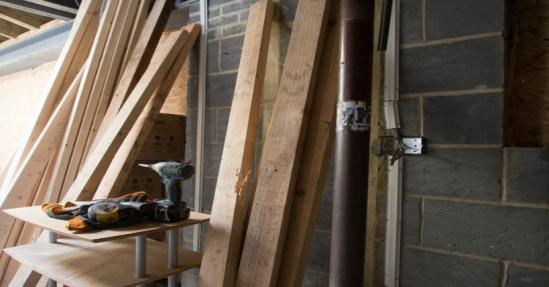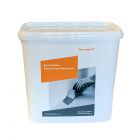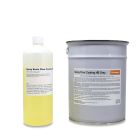Help & Advice Articles, Videos and How-to-Guides
Filter Articles

Garage Conversions: The Ultimate How To Guide
Garage conversions are rising in popularity among many UK homeowners who wish to turn an under-utilised area into an additional living space. In fact, as the UK’s housing market continues to climb, people are becoming more savvy when it comes to getting the most out of their space. Converting a garage into extra living space is significantly cheaper than gaining extra space by buying a bigger home.
Garage conversions can transform your property and are extremely versatile in that there’s no limit to what your conversion can be i.e. gyms, offices, toilets, cinema rooms, living space depending on your preference. Added to this is the possibility of adding value to a property without needing (in most cases) any planning permission!
As with any major home improvement, garage conversions need serious thought, planning and patience. Overlooking this could be the difference between an expensive disaster or the conversion of your dreams! Permagard have been helping people DIY it for years. We feel strongly about providing comprehensive technical guides alongside market-leading products so that our customers are armed with top-tier tools and know-how. So if you are considering upsizing your property, thinking about a garage conversion or even planning one, this garage conversion guide will cover everything you need to know!
Is it worth converting a garage?
Before you lift a single finger the first step is to consider whether it’s worth converting your garage at all. You’ll be investing time and money into this conversion so it’s worth considering a few things:
- Do you have the time? - A DIY garage conversion project will not happen overnight. depending on the type of conversion, you’ll be spending lots of your free time working on the project. Rushing a garage conversion is a sure way to make mistakes which will cost more money and more time. You should ask yourself whether you can honestly commit your weekends and free time to the project
- It’s a lot of work - Garage conversions require a lot of work since they are not built to the same standards as houses. They are essentially single skin blockwork structures. This means you’ll need to make them completely habitable by adding insulation, damp proofing, electrical wiring before even thinking about immediate decorations and features.
- Will you make use of the space? - A garage conversion is an exciting project but you must weigh up the cost of materials and your time with how much use you’re going to get from your conversion. For instance, converting a garage into a screening room can be quite costly on the basis of surround sound, projectors, speakers, lighting and furniture. If it only gets used once a year then was it worth your outlay and effort?
- Can you spare the space? - In most cases, a garage may seem like a great candidate for conversion because it’s full of junk, tools, paint cans and unwanted presents from Christmases past. It seems simple, get rid of the unwanted rubbish and convert the garage into something useful, but you need to assess where the contents of your garage will then go. It might go to the skip but valuable things that you want to keep will need to be stored somewhere else such as an attic or shed. If you don’t have the space to store your garage items then you might not be able to spare the space.
How much does a garage conversion add to your house value?
Besides the extra living space, the possibility of adding value to a property is also a big motivator for many homeowners. This added bonus often acts as the final nudge for homeowners to take the plunge. So, does a garage conversion add to your house value? The answer is, it depends... At the top end of the scale it’s possible to add up to 20%, but the golden rule is that some conversions add more value than others. As a rule of thumb, bathrooms and bedrooms tend to add more value than home cinemas, offices or playrooms.
In some locations, garages are extremely sought after and converting one might actually decrease the value of the property. With parking spaces and garages becoming rarer, a home with a garage can add as much as 5% in value. If adding value to your home is the sole reason for carrying out a garage conversion, make sure to get a professional valuation first. This will provide reassurance that a conversion won’t hurt your property’s existing value.
How much does a garage conversion cost?
Cost is always going to play a major factor when considering a garage conversion. Many garage conversion guides will try to provide you with a monetary figure which we feel is slightly misleading. Costs on the pound can vary, but the real value is in understanding the key areas that will influence cost when carrying out a garage conversion.
Type of conversion
The cost of a garage conversion depends on a number of factors. All garage conversions require waterproofing and insulation at a minimum, but different uses will always result in different costs. For example: a bathroom conversion will require plumbing porcelain goods and shower fittings whereas a bedroom requires very little in terms of extra fittings.
Exterior garage conversion
If you wish to alter the structure of your garage as part of the conversion, then this technically counts as an extension and will require planning permission. The associated costs of planning permission will be mainly around an architect’s fee for the drawing of plans and submission of the planning permission. Depending on the success rate, multiple applications may need to be made in which case this can incur quite a cost.
Costs for converting a listed garage
If you live in a listed property then you’ll have to apply for listed building consent. This is permission to alter any aspect of the property including the garage. Pre-planning advice for listed consent is very specific; you'll need to employ architects, structural engineers and building surveyors to work on the application and provide the documents such as a Design and Access statement.
Is your garage suitable for conversion?
Early on in the planning stage you need to determine whether your garage is structurally sound enough to support a conversion. Over time, some garages are likely to fall into neglect and suffer damaged foundations, worn brickwork and other structural instabilities. Garages built over 30 years ago can also contain asbestos which is very dangerous when distrurbed. To be sure, it’s best to seek the help of your local authority’s building safety department.
Planning a garage conversion
As with any major home improvement project, meticulous planning will ensure that your conversion stays in budget, serves your needs and is of a decent lasting quality. Before getting into cosmetics and decorations you need to plan from the smallest of details and be consistent in your approach. If something goes wrong or there’s a problem, you’ll likely have to spend more money, time and effort trying to fix the problem.
What's your budget?
Your budget will be the biggest influence on what you can achieve with the conversion project. It’s important to draw out a detailed budget with every single stage of the project, with both material and labour costs detailed. If you need to hire an architect for planning permission applications and any other third parties then this must be included. You should also ringfence extra funds in a reserve pot for any emergency overspends. The cost of materials fluctuate and are particularly high currently so you may find these costs passed on to you.
What do you want to achieve?
Before you start any work on the garage space you must be 100% sure about what you wish to achieve with your garage conversion. This means being sure that the plans, designs and fittings will serve your needs for the space. An example would be a home gym - think about the equipment you want to include, do you also want there to be space for multiple people to train at a time? Will the space be able to provide this?
DIY garage conversion vs professional build
Some people will choose between converting their garage themselves as a DIY project, working with a tradesperson/contractor to realise their vision or choose to hire architects to design the conversion, and construction professionals to carry out the work. Both have their advantages and drawbacks:
|
Pros |
Cons |
|
|
Professional build |
|
|
|
DIY |
|
|
Garage waterproofing
The difference in construction standards between garages and habitable properties are significant as garages are built to store equipment, not accommodate living. As garages are rarely built in a way that fully resists water ingress, waterproofing is essential when converting a garage into any kind of living space. More importantly, waterproofing your garage conversion must be done thoroughly as the slightest mistake can compromise your entire project, cost thousands of pounds in damage, and render your conversion uninhabitable.
Epoxy DPM
An epoxy DPM floor coating is a quick way to stop damp coming up through the garage slab and damaging your final floor finish. You may be laying a new concrete slab in which case an epoxy DPM allows you to progress your project without having to wait for the new slab to dry out.
Read our how to lay an epoxy DPM guide.
Tanking
Garage structures are vulnerable to both penetrating and rising damp. Both of these can result in moisture forming on the face of the garage wall. Tanking slurry is a cost-effective solution when it comes to waterproofing garage walls. Cementitious tanking slurry products such as PermaSeal Tanking are made from acrylic polymers that form an impermeable layer to prevent water ingress once applied to a wall.
Read our guide to tanking a garage for full easy-to-follow instructions.
Wall floor joint
Where the wall and floor meet is often prone to leakage and therefore a potential weak point. We recommend creating a reinforced fillet joint. To do this, you should chase out the floor to a minimum of 20mm x 20mm at the wall floor joint, cutting into the wall if possible. Flush out the chase and remove any debris.
Whilst this is still damp, apply one coat of tanking slurry 100mm up the wall and 100mm across the floor. Whilst the slurry is still tacky, apply PermaSEAL Fillet Seal over the tanking slurry and into the chase creating a cove from the wall to the floor.
Garage ventilation
Turning a garage into any kind of habitable space will require ventilation of some sort. This is one aspect of a garage conversion that’s a universal requirement regardless of what you wish to do with your space. Lack of ventilation can result in condensation, black mould, health problems and bad odour. There are many options for ventilating your new living space including:
- Windows - Windows are the simplest form of ventilation and can be placed wherever you wish. A combination of skylight and wall level windows is very effective as fresh air entering from the wall windows pushes the old stale air upwards and expels it through the skylight. To ensure your windows are providing adequate ventilation, any window should be at least 1/20th of the total area of your space.
- Trickle vents - Achieving constant airflow into your newly converted space without affecting the temperature is a balancing act. Trickle vents are small openings fitted in window frames and sashes that allow a small amount of fresh air to enter a room. The amount of air they let in is just enough to guarantee a fresh regular supply without losing too much heat.
- Venting - If your conversion plans involve turning your garage into a bathroom, shower or even a gym, then an anti-condensation vent such as the Perma-Vent will be required. Gyms and bathrooms will produce much more moisture than a home office conversion or cinema, and need a higher level of air change than normal. Alternatively, the Kair heat recovery ventilator will expel damp air and separate heat energy which is then re-circulated.
Garage conversion insulation requirements
Effectively insulating your garage conversion space is just as important as waterproofing it. The build detail of a garage is a simple single skin blockwork structure, meaning there’s no thermal buffer to prevent the movement of thermal energy in or out. Insulating the garage space is a fundamental step as it will make your space more comfortable and cheaper to heat.
Concrete garage conversion floor insulation
The typical garage floor is made from a large concrete slab which offers very little thermal conductivity. This means it takes a long time to take on the temperature of its surroundings. The slab is in permanent contact with the earth which means it’s constantly mirroring a cold ground temperature. The low thermal conductivity of a garage floor means that even through ambient heating, it’s virtually impossible to warm up. There are options when it comes to insulating a garage floor as part of a conversion.
Floating floor
A floating floor involves laying down solid flooring over a layer of thermal insulation sheets. This is a cost-effective choice for good garage floor insulation, making it popular among many DIYers. Floating floors are ideal if you wish to install laminate, vinyl flooring or engineered hardwood flooring. Above all, a floating floor is simple to install and it’s easy to replace individual tiles if some become damaged in the future.
A floating floor option means that you don’t have the added task of having to remove the concrete ground slab which can be an expensive job. When considering a floating floor, the thickness of both insulation panels and flooring can reduce the depth of the room by anything up to 5 inches. If your garage ceiling is lower than average, make sure you factor in the potential loss of depth and how this might affect your planned usage for the space.
Epoxy garage flooring
Epoxy floor paint is a resin-based coating that can be applied to bare concrete garage floors. It creates a smooth, attractive and extremely hard-wearing seal. Epoxy floors are tough, but also easy to clean whilst being very chemically resistant. This makes epoxy the flooring of choice for working garage floors and factories since it is very resilient against abrasions and scratches. It’s for this reason that an epoxy resin floor is a great option if you are converting a garage into a workshop, office or gym.
Garage conversion wall insulation
Wall insulation is key when it comes to retaining heat inside your garage space. Most garages have at least one wall facing the outside, with detached garages being exposed on all four sides to weather, wind and rain.
The typical single skin blockwork of a garage wall is never insulated so failure to properly treat them will result in a significant loss of heat. It goes without saying that garage conversion wall insulation is critical for energy economy and comfort, so you should achieve at least a 0.28 W/m2K U-rating when insulating the walls.
External wall insulation
A garage conversion can be insulated by treating the exterior or the interior walls. For detached garages, external insulation is great because you can achieve a uniform exterior without giving up interior space, a common downside to internal insulation. Exterior insulation is usually carried out by fitting insulation panels and render, or exterior insulation boards on the outer surfaces of the wall. Masonry conducts heat and coldness very quickly through cold bridging, a process where coldness travels through certain materials. By adding external insulation you are essentially creating a thermal buffer zone where coldness is prevented from reaching the blockwork and entering the garage.
Internal wall insulation
Internal insulation is probably most common in semi-detached garage conversions. This is because the thickness of an extra outer layer would look out of place next to the main property building. There are a few different ways of insulating internal walls but they mostly involve placing insulation panelling or rockwool between a wooden stud wall and the blockwork. Panelling can be substituted for insulation spray foam, insulated plasterboard or fibreglass rolls.
Garage door insulation
Many people choose to keep their garage doors when carrying out a conversion. A large metal garage door is highly thermo-conductive, so any quality wall insulation will count for little if warmth can escape through an uninsulated garage door. Likewise, during hot summer months an aluminium garage door will conduct heat, resulting in high internal temperatures.
Common materials for garage door insulation include polystyrene foam, panel insulation or reflective foil insulation. When insulating a garage door, the weight of the materials is very important as overloaded bulky doors will stress the lifting mechanisms and springs. This is why lightweight reflective foil tends to be a popular option and is included in many garage door insulation kits.
Insulating a pitched roof garage conversion
Roof insulation is crucial to heat retention. Since heat naturally rises, it’s important to prevent the movement of heat in and out of the garage roof. Failure to do this could mean high energy bills and a living space that will never fully warm up. If you are converting a garage with a pitched roof, you can insulate it in the same way you would insulate a loft by installing thick fibreglass panels over the roofing rafters.
Insulating flat roof garage conversion
If your garage has a flat roof, the methods of insulation are slightly different. You can either opt for a cold or warm roof system.
- Warm roof insulation - This involves fitting the insulation materials on top of the flat roofing deck just before the roof covering. The major benefit of this method is that you don’t lose any ceiling space since the insulation materials are placed closer to the roofing layer therefore making the roof space “warm”
- Cold roof insulation - This is where insulation is fitted between the joists that sit below the roofing deck. As the insulation doesn’t start until the joists, the subsequent roof space becomes cold. This method is slightly easier to carry out but does reduce interior ceiling space. Cold roofs will need to have a 50mm gap between any insulation panels to promote ventilation and prevent condensation.
Soundproofing a garage
Soundproofing is often overlooked when it comes to converting garages into living spaces. If a garage is being converted into bedrooms, offices or home cinemas, then these particular uses must be free from outside noise. Soundproofing acts as a way to reduce interference from traffic and street noises while also making sure any sounds you’re making don’t disturb the neighbours (home cinema speakers, workshop machinery, music etc). To stop sound energy from escaping, you need to create a room within a room.
- Timber wall frames - these are installed in rectangular rows along the inside of each wall and ceiling. They provide structure for the acoustic wool and paneling
- Acoustic wool - The timber frame gaps are then filled with acoustic wool as the main sound absorber
- Acoustic panels - Specialist foam acoustic panels will then be laid over the top of the foam-filled timber frame
- Plasterboard layer - Added as the final layer over your choice of insulation.
Permagard: helping your garage conversion stay dry
A quality garage conversion can have an amazing impact on your home whether it's an office, gym, workshop or bedroom. At Permagard we provide a range of industry leading waterproofing products that will protect your garage conversion for years to come. To find out more information browse our damp proofing products today.



